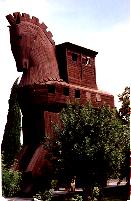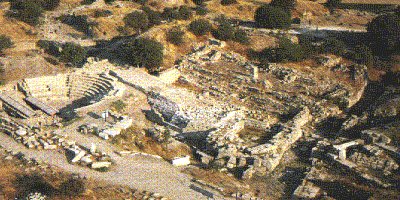Troy (Truva) - 4000 Years Old Ancient City

|
Troy is a city which existed over 4000 years and known as the center of ancient civilizations. Many years, people believed that it was the city in tales and never existed until it was first found. At this time it was known as Ilium or New Ilium. Today Troy or New Ilium places in Hisarlik at Canakkale. The remains of the city - the remains from the thieves and destructors - can be visit in here. Most of what was left is the remains of the destruction of Schliemann, the famous archaeologist. Today an international team of scientists brings the Troy of the Bronze Age back to life under sponsored project by Daimler - Benz and another team is at law wars - called as Second Trojan Wars today- with Russia and Germany to get stolen Trojan treasures.And Trojan Golds are at Pushkin Museum.
At first, Troy appared in Greek and Latin literature. Homer first mentioned story of Troy in Iliad and Odyssey. Later it became most popular subject in Greek drama and told its story eloborately to next generations. The book of Virgil's Aeneid contains the best known account of the sack of Troy. In addition, there are untrue stories under the names of Dictys Cretensis and Dares Phrygius.
In Bronze age, Troy has a great power because of its strategic position between Europe and Asia. In the 3rd an 2nd millennia BC, Troy was a cultural centre. After the Trojan War, the site was apparently abondoned from 1100 to 700 BC. About 700 BC Greek settlers began to occupy the Troas. Troy was resettled and named Ilion. Alexander the Great ruled over the area successively from the late 6th century BC. After Roman captured Troy in 85 BC. , it was restored partially by Roman general Sulla. After the occupation of Constantinople ( Istanbul ), Troy lost its importance.
'Ilium was for a considerable period to the Heathen world, what Jerusalem is now to the Christian, a 'sacred' city which attracted pilgrims by the fame of its wars and its woes, and by the shadow of ancient sanctity resposing upon it. Without abusing language, we may say that a voice speaking from this hill, three thousand years ago sent its utterances over the whole ancient world, as its echoes still reverberate over the modern', says Charles Maclaren, The Plain of Troy Described (1863). [From the book 'In Search of Trojan War', written by Micheal Wood].
'I would as soon as go in guest of Utopia, or of the Carib Island of Robinson Crusoe, and his Cabin; and I should return with equal emolument,' said the redoubtable Jacob Bryant of the search for Troy, which he thought never existed (1799) [From the book 'In Search of Trojan War', written by Micheal Wood].
Troy (Truva) located on Hisarlik at Canakale , one of the Turkish city in west of Turkey, the city of Dardanels, the heart of history at the World War I - Galliboli where Turks wrote the history at the World War I, Gallipoli Champaign. Canakkale has been a crossing point for armies, traders, migrating people since before history.
Charles Mclaren in 1822 found the ruins of Troy left from Helenistic and Roman Ilion at Hisarlik, Canakkale in Turkey. The German archiolog Heinrich Schlieman excavated Troy third times from 1870 to 1890. His theft of treasure from Troy and his demage (destruction) to Troy will be always rembered in Turkish archological history. Today the remains of Troy what left from Schiemann. A new German excavator team is still working to rebuild Troy ruins by using new advanced technologies since 1988. I believe after their study, Troy has a new apperance and visitors will enjoy it very much. You can find detail information about Troy excavating and high technology using in here. Also thanks to Daimler - Benz because of sponsoring troy excavating. In some writings, Schileman's credibility was began questioning. Troy, treasure and the truth is one of them.


Wihelm Dorpfeld followed to excavate after Schliemann. They found nine levels at Troy. Troy I to V relates roughly with early Bronze Age ( 3000 to 1900 BC ). Its inhabitants were known as Trojan in this period. Troy VI and VII were built in the Middle and Late Bronze Age. Troy VIII to IX belongs to Helenistic and Roman Ilion (Latin Ilium).
In the history, Troy was destroyed many times and rebuilt. Until now archeologists have founded 9 level of Troy lebeled fron I to IX. Perhaps many other levels are still hidden in it. Troy is one of the most famous city in the old history, including Hector, Rchiles and Archaian Greeks, the sake of Helen. Its story is written in ever language, Trojan horses, Archilles' heels and Odysseys have become figures in poems. From Alexander the Great to Lord Byron, they stood and gawed on the site of the great deeds of the heroes. In the history people always wondered whether the Trojan War happened or not. There Troy was. Did Helen of Troy exist? Was there a real wooden horse? Here is the famous tale of Trojan War and city of Troy
In 2009, a archological team found 2 human skeletons in the defensive ditch of the city of Troy [News from Milliyet]. Read more.